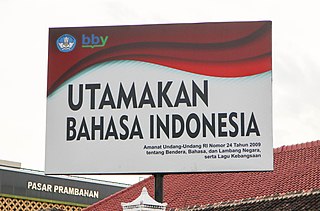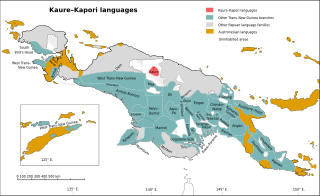Related Research Articles
Abau is a Papuan language spoken in southern Sandaun Province of Papua New Guinea, primarily along the border with Indonesia.
In linguistic typology, a subject–object–verb (SOV) language is one in which the subject, object, and verb of a sentence always or usually appear in that order. If English were SOV, "Sam oranges ate" would be an ordinary sentence, as opposed to the actual Standard English "Sam ate oranges" which is subject–verb–object (SVO).
Usku, or Afra, is a nearly extinct and poorly documented Papuan language spoken by 20 or more people, mostly adults, in Usku village, Senggi District, Keerom Regency, Papua, Indonesia.
Elseng is a poorly documented Papuan language spoken by about 300 people in the Indonesian province of Papua. It is also known as Morwap, which means "what is it?" ‘Morwap’ is vigorously rejected as a language name by speakers and government officials.
Waris or Walsa is a Papuan language of northern New Guinea. There are about 2,500 native speakers. It uses the Latin writing system. The language features monophthong, diphthong, and triphthong vowels.

The Bird's Head Peninsula or Doberai Peninsula is a large peninsula that makes up the northwest portion of the island of New Guinea, comprising the Indonesian provinces of Southwest Papua and West Papua. It is often referred to as The Vogelkop, and is so named because its shape looks like a bird's head on the island of New Guinea. The peninsula at the opposite end of the island is called the Bird's Tail Peninsula. The peninsula just to the south is called the Bomberai Peninsula.

Indonesia is home to over 700 living languages, creoles, and dialects spoken across its extensive archipelago. This significant linguistic variety constitutes approximately 10% of the world’s total languages, positioning Indonesia as the second most linguistically diverse nation globally, following Papua New Guinea. The majority of these languages belong to the Austronesian language family, prevalent in the western and central regions of Indonesia, including languages such as Acehnese, Sundanese, and Buginese. In contrast, the eastern regions, particularly Papua and the Maluku Islands, are home to over 270 Papuan languages, which are distinct from the Austronesian family and represent a unique linguistic heritage. The language most widely spoken as a native language is Javanese, primarily by the Javanese people in the central and eastern parts of Java Island, as well as across many other islands due to migration.

Pichinglis, commonly referred to by its speakers as Pichi and formally known as Fernando Po Creole English (Fernandino), is an Atlantic English-lexicon creole language spoken on the island of Bioko, Equatorial Guinea. It is an offshoot of the Krio language of Sierra Leone, and was brought to Bioko by Krios who immigrated to the island during the colonial era in the 19th century.
Kembra is a South Pauwasi language spoken in Western New Guinea by some twenty persons in Kiambra village, Kaisenar District, Keerom Regency. It is used by between 20% and 60% of the ethnic population and is no longer passed down to children.

Pegunungan Bintang Regency or Bintang Mountains Regency is a regency in the Indonesian province of Highland Papua. It was created on 11 December 2002 from the north-eastern districts of Jayawijaya Regency. It covers an area of 15,683 km2, and had a population of 65,434 at the 2010 Census and 77,872 at the 2020 Census; the official estimate as at mid 2022 was 78,466 - comprising 42,362 males and 36,104 females. The administrative centre is the town of Oksibil.
Buru or Buruese is a Malayo-Polynesian language of the Central Maluku branch. In 1991 it was spoken by approximately 45,000 Buru people who live on the Indonesian island of Buru. It is also preserved in the Buru communities on Ambon and some other Maluku Islands, as well as in the Indonesian capital Jakarta and in the Netherlands.
Massep is a poorly documented Papuan language spoken by fewer than 50 people in the single village of Masep in West Pantai District, Sarmi Regency, Papua. Despite the small number of speakers, however, language use is vigorous. It is surrounded by the Kwerba languages Airoran and Samarokena.

Kaure is a Papuan language of West Papua. It is spoken in the villages of Lereh, Harna, Wes, Masta, and Aurina.
Foi, also known as Foe or Mubi River, is one of the two East Kutubuan languages of the Trans-New Guinea family spoken along Lake Kutubu and Mubi River, located in the Southern Highlands Province of Papua New Guinea. Dialects of Foi are Ifigi, Kafa, Kutubu, Mubi. A Swadesh list for the Foi language was documented by The Rosetta Project in 2010. The estimated number of Foi speakers as of 2015 is between 6,000 and 8,000.
Bauzi is a Papuan language of the East Geelvink Bay family spoken in the Indonesian province of Papua.
Mairasi is a Papuan language of the Bomberai Peninsula of West Papua, Indonesia.
Mawes is an extinct Papuan language of Indonesia.
Yetfa and Biksi are dialects of a language spoken in Jetfa District, Pegunungan Bintang Regency, Highland Papua, Indonesia, and across the border in Papua New Guinea. It is a trade language spoken in Western New Guinea up to the PNG border.
Kimki (Aipki) or Sukubatom (Sukubatong) is a South Pauwasi language of Batom District, Pegunungan Bintang Regency, Papua, Indonesia. Foley classifies Kimki as a language isolate, although he notes some similarities with Murkim. Usher demonstrates a connection to the other South Pauwasi languages.
Tamashek or Tamasheq is a variety of Tuareg, a Berber macro-language widely spoken by nomadic tribes across North Africa in Algeria, Mali, Niger, and Burkina Faso. Tamasheq is one of the three main varieties of Tuareg, the others being Tamajaq and Tamahaq.
References
- ↑ Murkim at Ethnologue (18th ed., 2015) (subscription required)
- ↑ New Guinea World, South Pauwasi River
- 1 2 Foley, William A. (2018). "The languages of Northwest New Guinea". In Palmer, Bill (ed.). The Languages and Linguistics of the New Guinea Area: A Comprehensive Guide. The World of Linguistics. Vol. 4. Berlin: De Gruyter Mouton. pp. 433–568. ISBN 978-3-11-028642-7.
- Wambaliau, Theresia. 2004. Survey Report on the Murkim Language in Papua, Indonesia. (in Indonesian). Unpublished manuscript. Jayapura: SIL Indonesia.